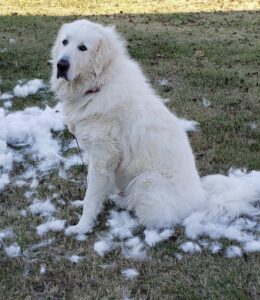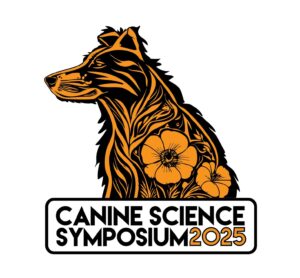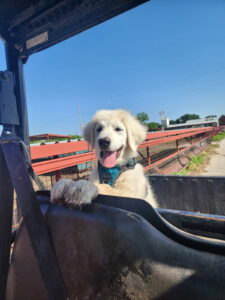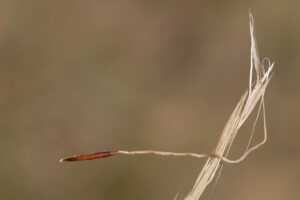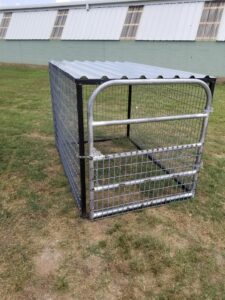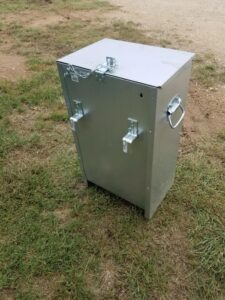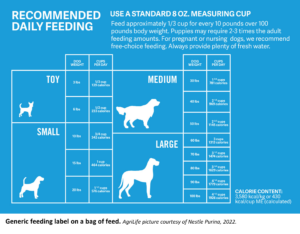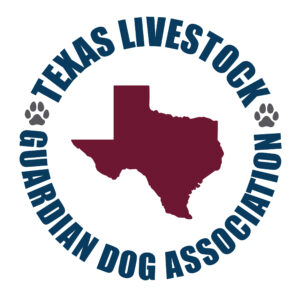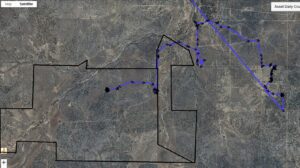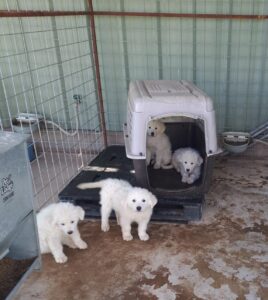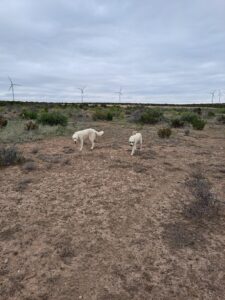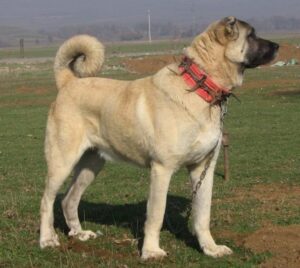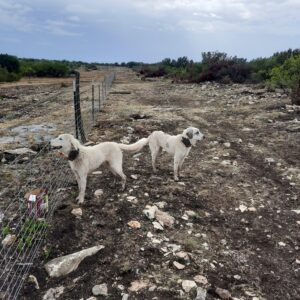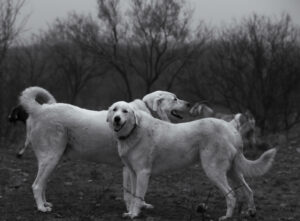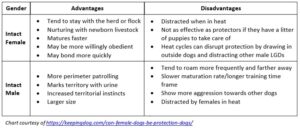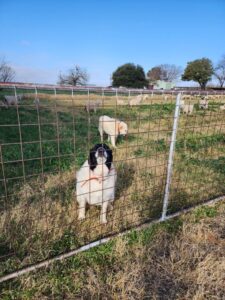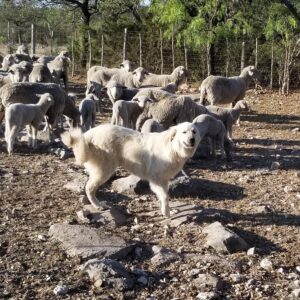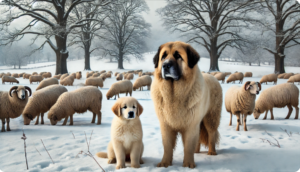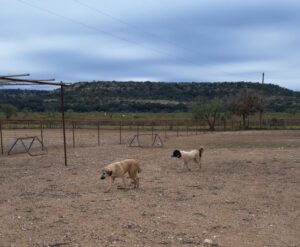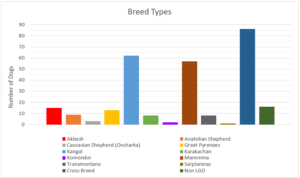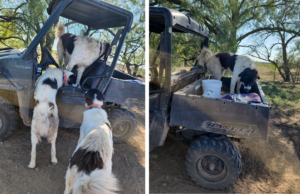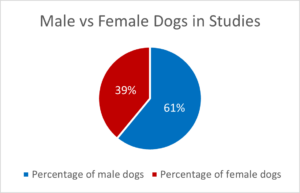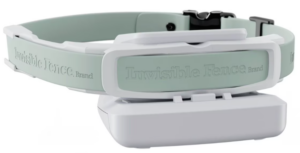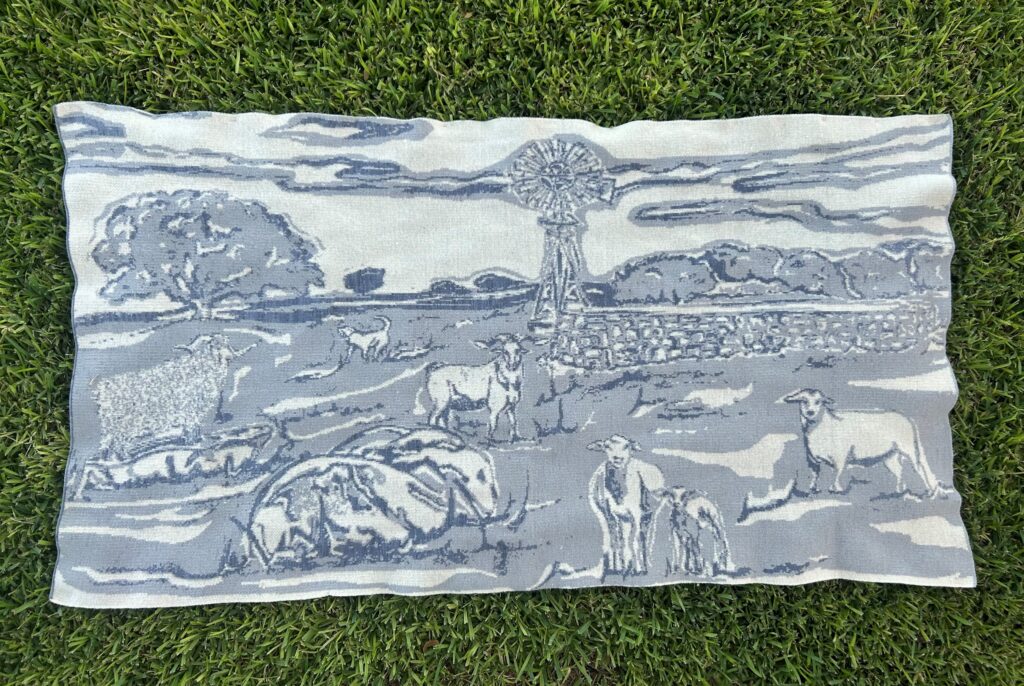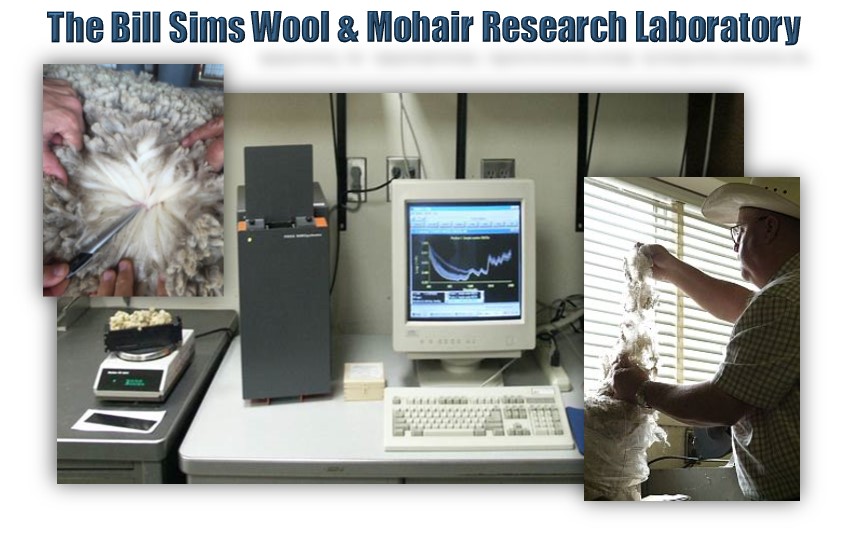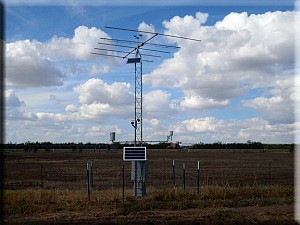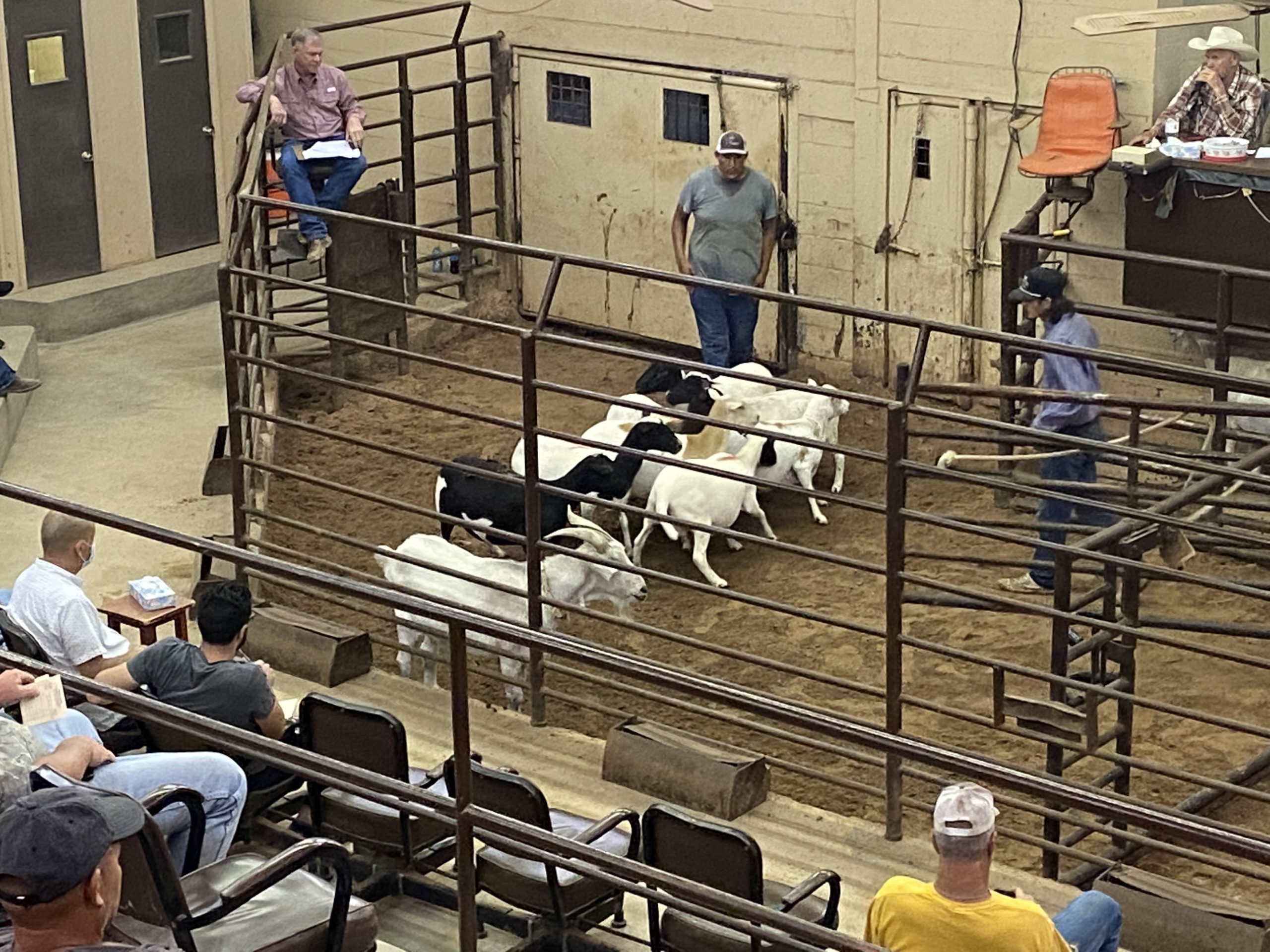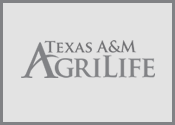
June flew by quickly for me, and I was glad to see the various rain showers at my place and around the state. The National Weather Service predicts that the 90-day temperature outlook will be above average, with near-normal precipitation levels. The expected rainfall is reassuring, especially since there were many rumors about a drought this year. However, the forecast of above-average temperatures for July and August is not very encouraging.
Make sure your LGDs are well-groomed and have access to plenty of fresh water and shade to stay cool. Dead hair care clogs the air channels in your LGD coat, leading to them overheating easily. You may also want to consider giving them some canine electrolytes, especially if the temperature in your area is extremely high. These can be found at most local pet stores and online. Heat stroke is a serious concern for long-haired LGDs, especially in high-humidity environments. You may need to trim their belly, lower chest, and inner leg hair to help them stay cool.
AgriLife Livestock Guardian Dog Program: Update and Events
We did not host an online seminar in May because we held the field day last month. Our next webinar is scheduled for August 21st at 3:00 p.m. This quarter’s webinar will focus on the Akbash breed. Akbash dogs are a white, short-haired breed of livestock guardian dog (LGD), originally from Türkiye, and they are a personal favorite of mine. Kristal Spenrath, a long-time LGD breeder and co-owner of Crazy Goat Socks, will present the webinar next quarter. Check our Facebook page (@TAMUlivestockguarddog) for more information and visit the events page on the Center’s website to register as the event approaches.
We also have Dr. Katherine Lord scheduled to present our November webinar. Dr. Lord will share data from the working dog collection of Darwin’s Ark Canine DNA Project, of which she is a member. We highly encourage all LGD owners to participate in the working dog project, helping to gather data on all types of working dog breeds. Check our Facebook page (TAMUlivestockguarddog) for more information and visit the events page on the Center’s website to register as the event approaches.
Training LGDs
Here is part two of a six-part series on training Local Guard Dogs (LGDs). Are livestock guardian dogs (LGDs) “untrainable?” This month, we will be reviewing positive training and basic obedience training for working LGDs.
Obedience Training LGDs Using Positive Methods
Are you uncertain what training with “positive methods” means? Here is a definition. We train dogs by making them want to do what we ask. We do not use force, punishment, or shame. How do we make them want to do the thing we are asking? Positive reinforcement makes training interactions fun, and the dogs should be treated respectfully. Training should feel like playing and be fun for the dog. Positive reinforcement may be giving the dogs a treat, praising them, a few minutes of play, or whatever they want, like ear rubs.
The dogs will view training and “obedience” as something fun. They will associate the training with the things they love most in life. Making the actions we want them to do worthwhile is beneficial for both them and us. By doing this, we learn to communicate with each other, strengthening our bond. All training should be done in conjunction with livestock. Please do not remove the LGD from the livestock to train them, as this can cause anxiety and make them more difficult to train.
For example, if the dog is barking excessively, show your dog that you acknowledge their concern. Take the dog with you to see what they are barking at, thank them for alerting you, tell them it’s okay, and use a command like “enough” or “leave it” to signal to the dog that their alert has been acknowledged and they can stop barking. The dog will see that we have taken their concerns seriously and respect us. This can be powerful for bonding with the dog and gaining their trust.
Training LGDs with positive methods is ethical and often very practical. Always treat the dog with kindness, and they will learn to obey. They obey us not because they fear us but because they trust us, view us as their partner, and want to please us. It is essential to remember that being too stern in training an LGD can cause them to become wary of humans and make them difficult to catch. Positive reinforcement should be used unless negative reinforcement is necessary to prevent a dangerous situation, such as when the dog is about to attack or when they are engaging in destructive behavior.
How to Start Obedience Training with Your LGDs
For optimal training, follow the steps listed below.
- Start with exercise. If the dogs are hyper or overly excited, they will struggle to learn anything new. Ensure they have had sufficient
exercise to be in a calm and receptive mental state.
- Avoid distractions. Dogs struggle to learn new things when they are distracted by intriguing sights, sounds, or smells around them. Set them up for success by training them in a low-key environment with livestock.
- Make training fun for them. Obedience training should feel like play, not work, for the dogs. Enjoy the time spent with them; knowing their personalities is vital for effective training.
- Reward them with a treat; this should be easy. Some dogs respond well to food rewards, whereas others prefer to play with a favorite tug toy for a minute or two or be praised and coddled.
- Take breaks. If a handler feels frustrated with the dogs, take a break. Keep training to about 15 minutes a day. Always end on a positive note. Take a few days off to reflect on any mistakes or issues that arose during training. Be patient with the dogs! Consistency with commands is essential for the dog’s success. Do not issue commands during breaks unless they are followed through with the dog.
After the dog masters a skill in one area, work on that skill in another location. For example, the dog may learn how to sit in the bonding
pen, but when asked to sit out in the field, she might be unable to do it. It would be best to teach her that the commands do not depend on the location. Continued training in new settings is vital to ensure the dog will obey the command in any situation.
Once the dog has mastered a command in multiple settings, gradually introduce more distractions over time. Training the dog to listen to a command is essential, even when they do not want to. Work on teaching the dog to respond to commands in various situations, such as around livestock, other dogs, people, and in uncomfortable settings, like on a busy road. It is also important to train them when they are hyper and have not had enough exercise. The dog must learn to listen to commands, regardless of the distractions or their emotional state. This is the only way to avoid dangerous situations.
Bonding Project Update
Round 7 Pups
The pups are all doing well and appear to have bonded with the cattle in their pens. The real test will be in late August when they are released from the pens and the pups have more room to wander from the calves. We regularly rotate the pups between the pens so that they get acclimated to different cattle. We are also using hot wire treatment in both pens this time to decrease the chance of roaming. While I would have preferred to single-bond the puppies to decrease further the chance of roaming, that was not possible this time due to budgetary constraints. Socialization and training are coming along well, and they are settling down during vehicle rides as well.
In closing
If you enjoyed this monthly LGD blog, please remember to subscribe using this link: The Guardian Way | Texas A&M AgriLife Research and Extension Center at San Angelo.
If you have any feedback about this article or would like to propose topics for future articles, webinars, or workshops, please contact me at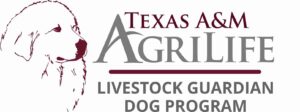 bill.costanzo@ag.tamu.edu or 325-657-7311.
bill.costanzo@ag.tamu.edu or 325-657-7311.
Seeking information on LGDs? Please visit our website, which features factsheets, global research on LGDs, and case studies we have conducted.
The Texas A&M AgriLife Livestock Guardian Dog Program is a collaborative initiative between Texas A&M AgriLife and the Texas Sheep and Goat Predator Management Board. Follow us on our social media platforms and share them with your friends and family!
Facebook, Instagram, YouTube: @TAMUlivestockguarddog
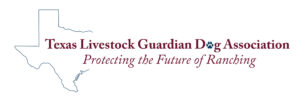 Be sure to visit the Texas LGD Association online! You can follow the organization on Facebook or YouTube under @TexasLGDAssociation or visit its website.
Be sure to visit the Texas LGD Association online! You can follow the organization on Facebook or YouTube under @TexasLGDAssociation or visit its website.
Texas A&M AgriLife provides equal opportunities in its programs and employment to all persons, regardless of race, color, sex, religion, national origin, disability, age, genetic information, veteran status, sexual orientation, or gender identity. The Texas A&M University System, U.S. Department of Agriculture, and the County Commissioners Courts of Texas Cooperating.

